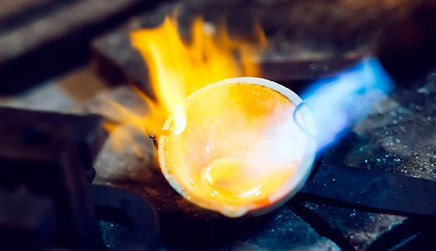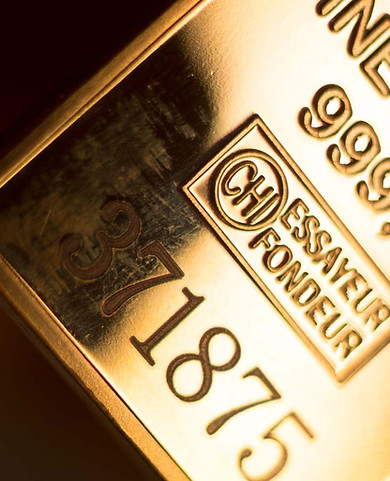


Golden opportunities

AU (AURUM)
Gold: Known as "aurum" in Latin, this symbol on the periodic table stands for the element gold, which has the atomic number 79.
Gold leaf
Term for a thin foil made of pure gold. It is used to give the impression of solid gold (gold plating). To produce it, pure or high-carat gold is poured into small bars 2-5 millimeters thick, which are first rolled to the thickness of newsprint (approx. 30 micrometers) and then beaten in several steps to a thickness of 100-110 nanometers (0.00011mm) to form gold leaf. For comparison, the thickness of a human hair is 0.08mm. This means that it takes over 700 layers of gold leaf to reach the thickness of a single hair, which illustrates the enormous ductility of gold.


Precious metal
Noble is a chemical name for elements that are permanently chemically stable in a natural environment under the influence of air and water.
For metals with this designation, this means that they cannot corrode or can only corrode very slowly. This is why precious metals such as gold and silver occur naturally in nature, in contrast to iron, which only occurs in bound form as iron oxide or iron carbonate and therefore has to be chemically separated from other ore components after mining. Noble can also be used as an economic term, but there is no fixed definition. For example, copper meets the chemical definition of noble, but not the economic one.
Color gold
Classic jewelry gold alloys belong to the three-component system gold-silver-copper.
Until the 19th century, it was even forbidden in Europe to alloy gold with anything other than the three metals. The color spectrum of such alloys ranges from rich yellow to light green and salmon pink to silver-white. By varying the amounts of alloyed metal or adding additional metals, all color gradations can be achieved.
Well-known gold alloys in this category are red gold/rose gold, yellow gold, green gold and white gold.

Rings in gold color.

Rings in rose gold color.

Rings in white gold color.

Fine Content
This term describes the proportion of a precious metal in a product.
A 24 carat investment bar therefore contains 999.9 parts of pure gold out of 1000 parts. Gold jewelry is usually made of 14 or 18 carat gold, which corresponds to a fineness of 585/000 or 750/000.
Fine gold / investment gold
Fine gold or investment gold, represented by bars or coins, is of particular importance in the area of precious metals. These products are characterized by an outstanding fineness of 24 carats, which corresponds to a pure 999 alloy. This high purity makes fine gold a sought-after investment option.
“Fine gold” stands for an exceptionally high gold content of 999.9 per mille, without any admixtures of other metals. This purity is not only aesthetically pleasing, but also crucial for investors looking to preserve value.
Overall, Feingold reflects the precision and high standards that investors value in their search for value-preserving investments. The popularity of investment gold with a fineness of 24 carats illustrates the attractiveness of pure gold as a safe investment and the ongoing fascination with the beauty and value of this precious metal.


Fine gold bars in different sizes.
troy ounce

One troy ounce of gold in bar form.


One troy ounce of gold in coin form.
In the area of precious metals, the distinction between the conventional ounce and the troy ounce is crucial. While a normal ounce weighs 28.35 grams, the troy ounce specifically represents a mass of 31.11 grams in precious metal trading.
The troy ounce is of great importance for trading precious metals such as gold, silver, platinum and palladium. Their designated weight serves as a standard unit of measurement when it comes to valuing and trading these valuable metals. When buying or selling precious metals, the price is always stated per troy ounce, which defines the exact value based on 31.11 grams.
This distinction is crucial to avoid misunderstandings in precious metal trading. When purchasing precious metals, it is important to know which ounce is used as a reference in order to understand the exact value of the quantity purchased.
The troy ounce illustrates the precision required in the precious metals sector to ensure transparent and efficient trading. It is therefore advisable to always be clear about the units of measurement used and their exact definitions when conducting transactions in the area of precious metals.
coating sample
Classic jewelry gold alloys belong to the three-component system gold-silver-copper.
Until the 19th century, it was even forbidden in Europe to alloy gold with anything other than these three metals. The color spectrum of such alloys ranges from rich yellow to light green and salmon pink to silver-white. By varying the amounts of alloyed metal or adding additional metals, all color gradations can be achieved.
Well-known gold alloys in this category are red gold/rose gold, yellow gold, green gold and white gold.


Cast ingots
For larger quantities such as 250 grams and more, the so-called casting process is used. Here, a precisely weighed amount of metal granulate is melted down and poured into an ingot mold to form a cast ingot. The subsequent cooling process creates process-typical irregularities such as cooling rings or slightly irregular surface structures. The bar is then reweighed and, if the weight is correct, hallmarked with the mandatory information (manufacturer's information, weight, fineness and serial number).
Fulminating Gold
“Fulminating gold” is a term that refers to a substance discovered by alchemists over 400 years ago. It is a form of gold that not only has explosive properties, but also produces purple smoke when it explodes. The exact chemical process and composition of fulminating gold has long been a mystery. The substance is created through various reactions of gold salts with ammonia or ammonium chloride. The banging properties of bright gold make it an interesting, if historical, discovery in alchemy. A recent study found that the purple smoke from the explosion contained nanoparticles of metallic gold, clarifying the long-standing question about the origin of the smoke's color.
.jpeg)
Purple smoke (Photo Johannes Sterba)
.jpeg)
Gold explosion(Photo Johannes Sterba)
aqua regia
An acid mixture of hydrochloric and nitric acid in a ratio of 3:1 which is the only one able to dissolve gold. The dissolved gold can be precipitated again by adding chemical substances, a process that affineries use to produce fine metals of high purity.


Gold price development LBMA

Logo LBMA
LBMA
The London Bullion Market Association (LBMA) controls the over-the-counter trading of gold and silver and sets the world market price for the same.
Its members are major international banks, manufacturers, refiners, processors, producers and traders around the world.
Alloy
A mixture of two or more metals in a molten state.
Metals are alloyed to alter their natural properties such as color, price, density, corrosion resistance, mechanical strength and polishability.


Nugget
Translated into German as "Klumpen", this refers to a lump of gold or platinum that has formed naturally. The gold content of such a nugget is between 85 and 95%. They are normally the size of dust or grains, although there have been a few notable exceptions in history, such as the "Welcome Stranger" nugget from Australia, which had a gold content of 72 kg, or the "Leg of Mutton" from Canada with a gold content of 61 kg.
Embossing bars
Smaller quantities of gold, such as 100g and less, are produced in the form of so-called embossed bars. The production steps here differ from those for cast bars.
After the gold has been melted down, it is brought to a precisely defined thickness using rolling machines, from which the desired ingot shape is then punched out. These are known as blanks ("rounds" in the case of round shapes). These are then passed on for stamping, where the classic ingot shape, the motif and the hallmark are stamped under high pressure.


Hallmark
Hallmarking, the embossing of information such as weight, fineness and manufacturer on gold bars and gold jewelry, is mandatory for all gold products on the market. These embossed details provide buyers with clear information about the gold they are purchasing, including weight, purity and manufacturer. This commitment is not just for aesthetics, but more importantly to ensure the integrity of the gold market by protecting buyers from counterfeits and instilling trust. Hallmarking thus becomes an essential sign of quality and trust in the gold trade.
Refinery
Refineries are indispensable players in the gold industry. These companies not only melt down raw gold, but also refine it to produce high-quality gold products such as bars or coins. The process involves melting down the raw gold, cleaning it of impurities and precise refining. Refineries use advanced technologies to ensure the highest quality standards.
The importance of a refinery also extends to the recycling of scrap gold, which contributes to the sustainable use of resources. These facilities play a central role in the entire life cycle of gold - from the processing of the raw material to the production of high-quality gold products.




Wiener Philharmoniker
A fine gold coin minted by the Austrian Mint since 1989. It is an official means of payment, but as it is a bullion coin (investment coin), it is not traded at face value, but at the precious metal value. The motif, consisting of the instruments of the famous Vienna orchestra, is not changed, only the year of minting. Since the first minting, the coin has shown the instruments of the famous Vienna orchestra on one side. These consist of a horn, bassoon, harp, two violins, two violas and a cello in the middle. The organ from the golden hall of the Vienna Musik Association can be seen on the other side.
Dental Gold
Known in technical jargon as “dental gold” or “dental alloy”, it is often popularly referred to as dental gold. As early as 1000 B.C. Around 500 BC, the Chinese used gold leaf to fill tooth decay holes after treatment, while the first dental prostheses appeared around 500 BC. were made by the Phoenicians.

Today, there are a variety of materials and alloys in dentistry, both metallic and non-metallic. Metal alloys are divided into precious metal alloys (gold, silver, palladium, platinum) and non-precious metal alloys (cobalt, iron, nickel, copper, titanium, tungsten, ...). In particular, dental gold made from alloys with a high proportion of gold/platinum group metals can be quite valuable, as the precious metal content is 85% or more. A plate of dental gold (approx. 1g) could be worth around €40 with a gold sales price of around €58.60/g.
Therefore, a note for your next visit to the dentist: If you have dental gold, such as dentures or bridges, exchanged or replaced, remember that your dentist is obliged to give them to you. After all, you paid for it and are the legal owner. Many dentists sometimes forget this and sell the collected gold themselves, as just a few grams can quickly be worth a hundred euros or more.

Melter Assayer / Essayeur Fondeur
Each gold bar is hallmarked with regard to weight, fineness and manufacturer. You often read the term “melter assayer” or “essayeur fondeur” next to the manufacturer’s hallmark, but what does that mean?
These terms come from English and French respectively and mean “melt inspector” and “smelter” and “tester”. With this, the manufacturer of the gold bar states that it not only manufactured the bar itself, but also tested it and thus guarantees the quality and purity of the gold bar. These two terms do not always appear together, for example a company can only refine gold and produce the bars “melter” and have them tested by an independent or third-party company “assayer”. Most of the time, manufacturers test their bars themselves, as this means there are fewer additional costs for testing and secure transport.

Melting mark Heimerle + Meule

Melter's mark Valcambi S.A.






